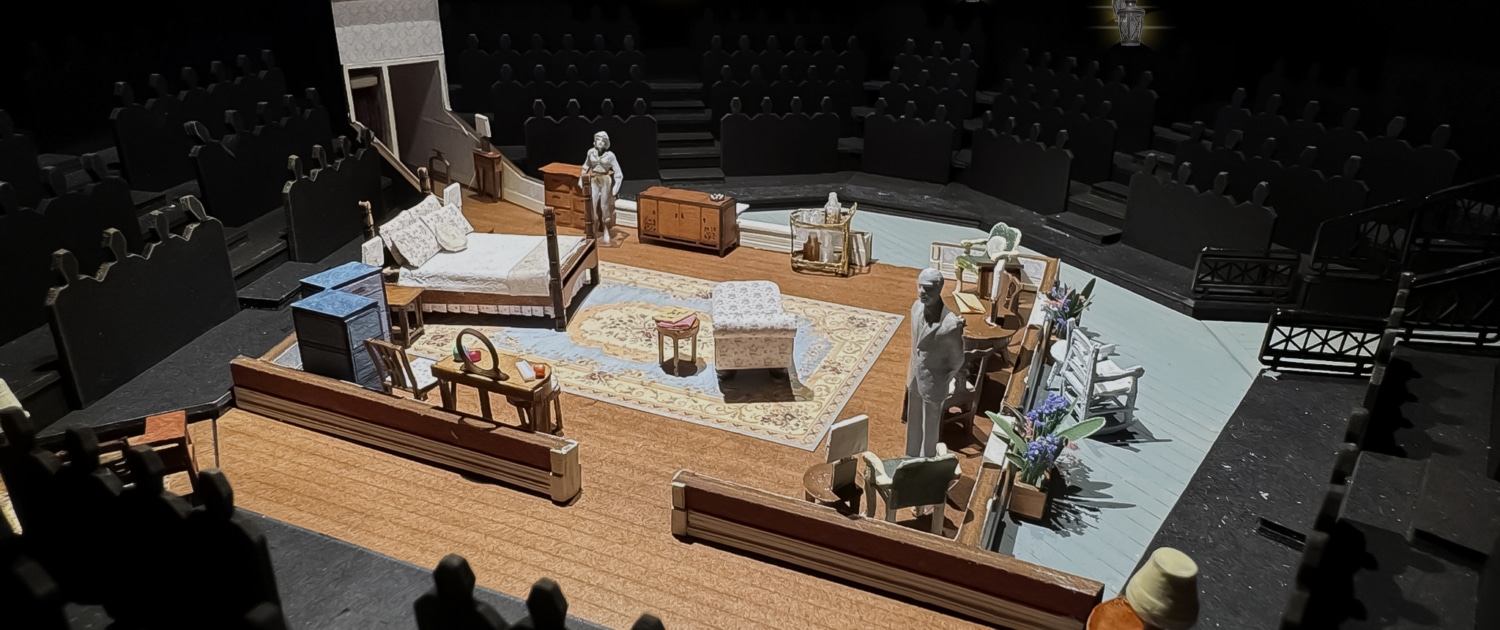DCPA NEWS CENTER
Enjoy the best stories and perspectives from the theatre world today.
Enjoy the best stories and perspectives from the theatre world today.

Longtime Denver Center Theatre Company patrons are used to being close to the action for shows in the Kilstrom Theatre — from food fights and space orbits to taking a shower and cooking in a kitchen. This 380-seat theatre-in-the-round has only seven rows, creating an intimate connection between actor and audience.
In Tennessee Williams’ Cat on a Hot Tin Roof, audience members will feel as if they are part of the family drama. They are so close, in fact, that they could touch the tension that feels like an actual character in the play. According to Scenic Designer Lisa Orzolek:
If you are sitting near the stage, chances are you are closer to an actor than their counterpart who is 30 feet away. Our theatres are amazing for how close the audience is to the action.
Because Artistic Director Chris Coleman has chosen to stage this production in-the-round, the design requires that an audience can see through the various set pieces, eliminating high walls, solid doors, and separate spaces. Instead, these spaces are defined through lighting, half walls, and door frames.
The size of the estate isn’t conveyed through the scenic elements; rather, it is implied through movement on and off stage. Williams sets the play on the Pollitt estate — 28,000 acres of cotton in the Mississippi Delta during a sweltering summer in the 1950s. The Theatre Company production stays true to the script, using four of five voms to create a sense of largess to the plantation house. One actor may step through a door frame and out onto the gallery or into a hallway, each of which leads to a vom. These spaces between seating areas allow actors to enter and exit the stage. “Our actors will exit one vom and reenter through another. The amount of travel will imply a bigger house,” Orzolek said.
While many theatres opt to embrace a southern gothic atmosphere of history, decay, and darkness for Cat on a Hot Tin Roof, Orzolek’s design remains relatively simple. She draws upon European influences to denote wealth and pairs them with fabric and furniture that is typical of the South in this period. “We search through our warehouse first to see what we own, looking for period pieces evocative of the 1940s,” she says. “The trick is to select furniture that all looks good together to create a seamless aesthetic that implies one person designed a room.
One element that is true to the period is using the same pattern everywhere — in the drapes, bed coverings, furniture upholstery, and wallpaper.
As the heat rises, so too does the strain among the characters who are vying for Big Daddy’s favor…and inheritance. A single ceiling fan is the only scenic element to imply rising temperature. “The heat will be translated more through the costumes, sound, and lighting design,” Orzolek explains. “Women may unbutton their blouses. Men may roll up their sleeves. Their clothing will become looser while their actions will be accompanied by the typical hum of bugs in the summer. And lights can make the stage feel hot or cold with the color and intensity of light that is used.” Beyond that, she says, the dialogue fills in the rest of the grandeur audiences expect.
While the physical design of the set shapes the audience’s experience, it’s the symbolic elements — particularly one central piece — that deepen the emotional resonance of the production. The play is well-known for its symbolism and there is no greater symbolic element than the bed, which is placed in the center of the stage. As the focal point of the play, the bed symbolizes unfulfilled possibilities, inner conflict, and lost dreams.
In this production of Cat on a Hot Tin Roof, the scenic design does more than set the stage — it deepens the emotional intensity and symbolic weight of the story. Every detail reinforces the play’s themes of longing, legacy, and illusion, making the audience not just observers, but participants in the Pollitt family’s unraveling.
DETAILS
Cat on a Hot Tin Roof
Oct. 3-Nov 2, 2025 • Kilstrom Theatre
Tickets
